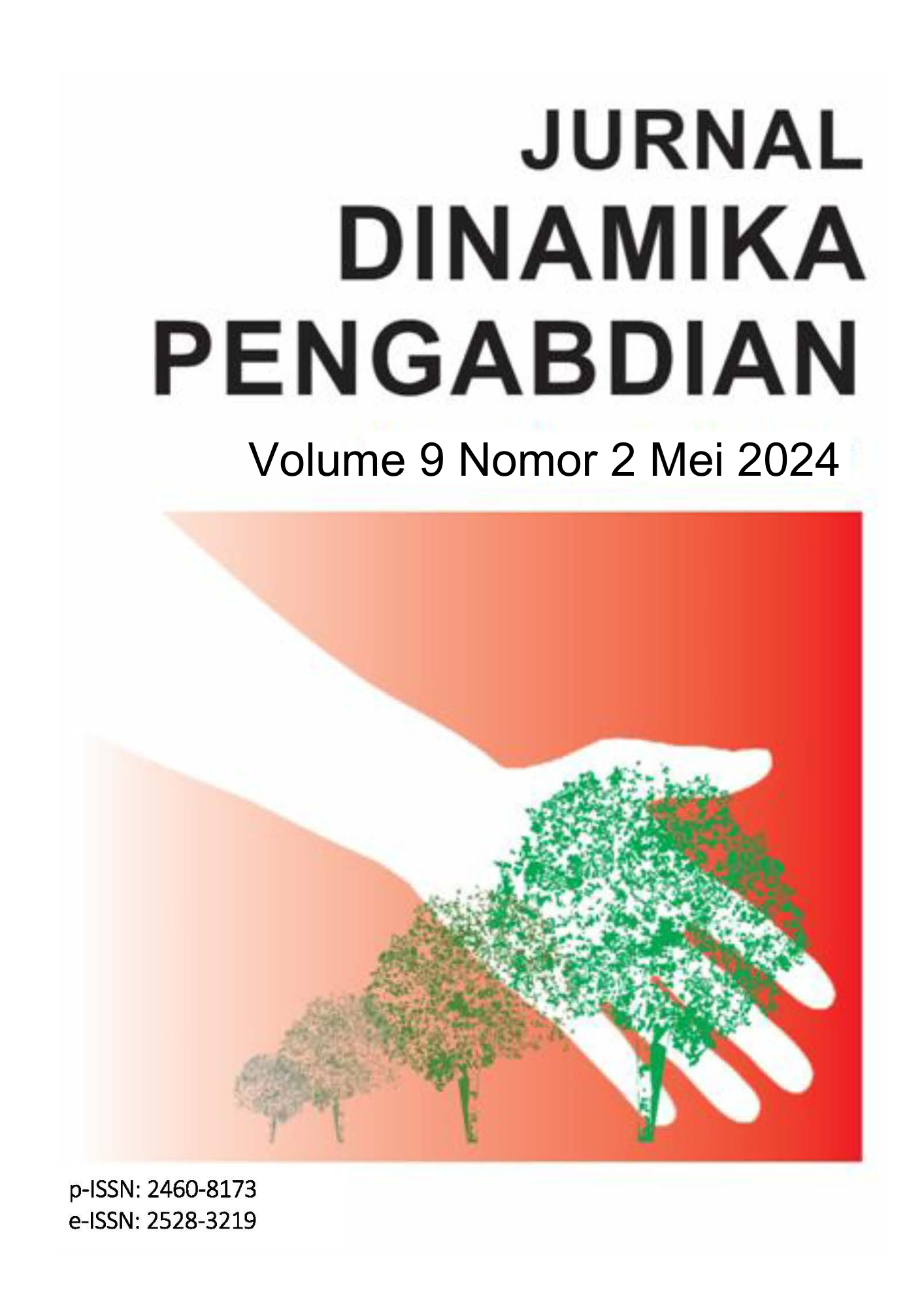PEMBINAAN KELOMPOK TANI KEDELAI DALAM PENERAPAN TEKNOLOGI WATER MANAJEMEN PADA BERBAGAI MODEL IRIGASI DI DESA JE'NETAESA KABUPATEN MAROS SULAWESI SELATAN
DOI:
https://doi.org/10.20956/jdp.v9i1.28578Keywords:
Soybean, rain harvest, inundated irrigation method, canal irrigation methodAbstract
Tantangan penyediaan pangan semakin hari semakin berat, degradasi lahan dan lingkungan, baik oleh ulah manusia maupun gangguan alam, semakin meningkat terbatasnya ketersediaan air pada lahan kering yang merupakan faktor yang sangat penting dalam peningkatan produksi tanaman, olehnya itu tindakan konservasi air sangat dibutuhkan untuk keberlanjutan penyediaan air terutama bagi lahan kering sehingga keberlanjutan pangan akan terus bisa berdaulat. Upaya konservasi air memerlukan komitmen dari semua pihak terhadap isu keberlanjutan air. Apabila memanen air hujan dipraktekkan secara berkesinambungan akan dapat membantu memelihara keberlanjutan air dan keberlanjutan lingkungan sebagai pendukung perikehidupan generasi sekarang dan yang akan datang. Tujuan dari program PkM adalah memberikan pengetahuan kepada petani di wilayah mitra tentang bagimana mengelola air hujan dengan menampung air hujan yang berlebih saat musim hujan (panen hujan) serta pengetahuan bagaimana membuat beberapa model irigasi yang sederhana yang bisa diterapkan saat musim kemarau sehingga efisiensi penggunaan air bisa tercapai, mengingat jumlah air saat musim kemarau sangat terbatas. Metode pendekatan yang digunakan dalam pelaksanaan Ipteks tersebut adalah dengan metode penyuluhan dan bimbingan teknologi. Hasil kegiatan PkM adalah masyarakat jadi mengetahui tentang cara memanen air hujan dan membuat irigasi sederhana (genangan dan saluran), dan masyarakat disana sudah sadar dan memahami akan pentingnya memanen/menampung air hujan disaat musim hujan yang nantinya nanti air tampungan tersebut bisa dimanfaatkan untuk berbagai keperluan.
Kata kunci: Kedelai, Panen hujan, Metode irigasi genangan, Metode irigasi saluran.
ABSTRACT
The challenge in providing food is getting harder, which caused by land and environment degradation due to the increasement of intensity human and nature behaviour. Fertile lands for agriculture are shifting significantly for non-agriculture purposes. As a consequence, the cultivitation activities move to critical lands (dry land), which require high input and quite expensive to produce food products. Effort to conserve water requires commitment from all party towards the water sustainability issue. If rainwater harvesting is practiced on an ongoing basis, it will be able to help maintain water sustainability and environmental sustainability as a support for the livelihoods of present and future generations. The aim of the community service program is to provide knowledge to farmers in partner areas about how to manage rainwater by accommodating excess rainwater during the rainy season (rain harvesting) as well as to educate them on how to make some simple irrigation models that can be applied during the dry season so that water use efficiency can be achieved, considering the amount of water during the dry season is very limited. The approach method used in the implementation of the science and technology is the counseling method and technology guidance. The results of the community service activity are to make the community aware how to ripe water from the rain and build a simple irrigation (inundation and canal). In addition, the targeted community have awared and known the cruciality of containing the rain water which will be used later for various needs.
Keywords: Soybean, rain harvest, inundated irrigation method, and canal irrigation method.
References
Alam, I., Lee, D.G., Kim, K.H., Park, C.H., Sharmin, S.A., Lee. 2010. “Proteome Analysis of Soybean Roots Under Waterlogging Stress at An Early Vegetative Stage,” J. Biosci, vol. 35, pp. 49– 62.
Aminah, Abdullah, Nuraeni, Marliana S Palad., & Rosada, I. 2020. Effectiveness of Water Management Towards Soil Moisture Preservation on Soybean. International Journal of Agronomy. Vol. 2020. Hindawi Publisher, USA.
http://downloads.hindawi.com/journal s/ija/2020/8653472.pdf
Aminah, Fadjry Djufri, Abdul Wahid Rauf, Saida, Marliana S Palad & Salim, 2021. Effectiveness Of Irrigation Methods And Time Of Providing Water In Maintaining Soil Classification For Increasing Soybean Production. AGRIVITA Journal of Agricultural Science. 43(3): 627-634. https://agrivita.ub.ac.id/index.php/agri vita/article/view/2975
Liaw Chao-Hsien & Yao-Lung Tsai, 2004, Optimum Storage Volume of Rooftop Rain Water Harvesting System for Domestic Use, Journal of the American Water Resources Association; Aug 2004; 40, 4; Proquest Agriculture Journals pg. 901.
Chiras, Daniel D., 2009, Environmental Science, 8th Edition, Sudbury, Massachusetts: Jones and Bartlett Publisher.
EEA, 2012. Water Resources in Europe in the Context of Vulnerability. EEA 2012 State of Water Assessment. EEA Report No 11/2012. European Environment Agency.
Evandro H.F.M. da Silva, Alexandre O. Gonçalves, Rodolfo A. Pereira, Izael M. Fattori Júnior, Luiz R. Sobenko, Fábio
R. Marin, 2019. Soybean irrigation requirements canopy-atmosphere coupling in Southern Brazil. Agricultural Water management 218 (2019) 1-7. https://doi.org/10.1016/j.agwat.2019.03. 003
IPCC, 2007. Climate Change 2007: Fourth Assessment Report of the Intergovernmental Panel on Climate Change. IPCC, Cambridge, United Kingdom/New York, NY, USA.
Martínez-Fernández J, González-Zamora A, Sánchez N, Gumuzzio A, Herrero- Jiménez CM (2016). Satellite soil moisture for agricultural drought monitoring: Assessment of the SMOS derived soil water deficit index. Remote. Sens. Environ. 177: 277–286.
Nasiah, Suprapta, Ichsan Invanni Baharuddin, 2021. Zonasi Daerah Rawan Kekeringan di Kabupaten Maros Provinsi Sulawesi Selatan. Seminar Nasional Hasil Penelitian 2021 “Penguatan Riset, Inovasi, Dan Kreativitas Peneliti Di Era Pandemi Covid-19” .ISBN: 978-623-387-014-6
Sasongo, Agung, 2020. Kekeringan Ancam Sektor Pertanian di Maros. Republika.co.id.
Side, Syafruddin, Wahida Sanusi dan Nasiah Badwi. 2019. Pemodelan Matematika SIRS, SEIRS dan Pemetaan Wilayah Endemik Demam Berdarah di Sulawesi Selatan. Laporan Penelitian. Dikti.
Sharpe, William E. and Swistock, Bryan., 2008, Household Water Conservation, College of Agricultural Sciences, Agricultural Research and Cooperative Extension College of Agricultural Sciences, The Pennsylvania State University.
WHO (2004), www.who.int.
Worm, Janette & Hattum, Tim van., 2006, Rainwater Harvesting For Domestic Use, Agrodok 43,Agromisa Foundation and CTA, Wageningen.
Downloads
Published
Versions
- 2023-11-06 (2)
- 2023-11-06 (1)
How to Cite
Issue
Section
License
Copyright (c) 2023 Jurnal Dinamika Pengabdian (JDP)

This work is licensed under a Creative Commons Attribution 4.0 International License.
Penulis diwajibkan untuk menandatangani "Surat Perjanjian Hak Cipta" atau Copyright Agreement untuk penyerahan ijin kepada pihak jurnal untuk menerbitkan tulisannya.
Authors are required to sign a "Copyright Agreement" to submit permission to the journal to publish their writings.







